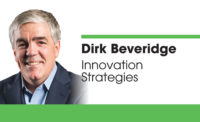As distribution leaders, we areat a unique moment in our careers.
In collaboration with the National Association of Wholesalers’ Institute for Distribution Excellence, Iconducted a research survey with distribution leaders and found the following:
- 76% of respondents believe they are living in an environment we could call the age of disruption.
- 85% feel they need to reinvent their business before someone else does.
As we look at the world around us, we can understand and relate to those with the responsibility of securing and creating their company’s future. As leaders, we have the responsibility to navigate the systemic shifts that are impacting our society, economy, the industries we serve and, of course, our businesses. Let’s look at some of those shifts.
Technology
Technology has a pace that is unfathomable. This pace includes technologies such as the cloud, Internet, eCommerce, big data, CRM tools, ERP software, “Internet of things” and the like that are changing the game for businesses. We hold more technology power in our smartphone than the technology on board a $500 million naval destroyer two decades ago. Both our suppliers and customers are demanding new business
processes that leverage this technology.
Demographics
By 2020 we will have five different generations in the workforce. Each generation of employees and customers will have unique sets of needs, wants and desires. This changes the game on how we sell, market, collaborate and lead. Top-down uninspired management will no longer attract the talent required to compete. Customers will tire from the interrupting marketing tactics of yesterday and are demanding we reach out when invited. And the very thing we have claimed distribution to be, “a relationship business,” is morphing into a multigenerational workforce that is redefining the word relationship.
Competitive environment
We know the competitive landscape is changing. I look at the evolution of competition within distribution in this way: first, we competed locally against other family-owned (one- or two-location) distributors and then as the market grew, regional players entered and the list expanded as well as the sophistication of competition. Yet a few years later, a national player or two saw the market’s opportunity and appeared in a big way with its professional management team just as nontraditional big box stores started encroaching in as well.
And today the competitive environment is being reshaped once again by our next wave of nontraditional competitors such as eBay, Google and Amazon.
Be alarmed
Of course we’ve just touched the surface regarding the possible disruptive trends impacting distribution and our businesses. We all know, hell, we can feel the pressure, and at times feel weighted down by all that is coming at us in so many directions.
Despite these disruptions, as I observe industry chatter and writings I hear legacy thinking that won’t serve us well going forward:
“Amazon’s foray into industrial supplies as a ‘wholesale slaughter’ is overstated.”
“This doesn’t need to be a big deal for most companies if they are well run.”
“Let’s not use the word disintermediation.”
This type of chatter plants the seed that change — and certainly transformation — is not required. It lulls those around you into a well-being of complacency and satisfaction. And these findings from our survey come as no surprise:
- 72% of distribution leaders believe the pace of change is too slow in their business.
- 78% feel they get trapped in the day-to-day, the tyranny of the urgent and don’t focus enough on creating the company’s future.
I’m not an alarmist, but I am alarmed with these findings and the standstill chatter coming from the industry. When I’m asked to speak at association conventions and annual company meetings I often outline what I call the disruptive wheel of change and the inherent inertia with most distributors. This inherent inertia of legacy thinking creates a strong pull to safety and a reluctance to change.
This is your opportunity. While we may not be satisfied with the pace of change in our business, we have been given the gift to lead in the age of disruption. Times like these don’t come around often.
Rather than listening or propagating the industry chatter of the status quo your opportunity is in seizing the moment,peering into the future, making sense of these disruptive forces and crafting a narrative — a story that unites your organization around the why, how and what of change, transformation and innovation.
We have been given the gift to lead in the age of disruption.





